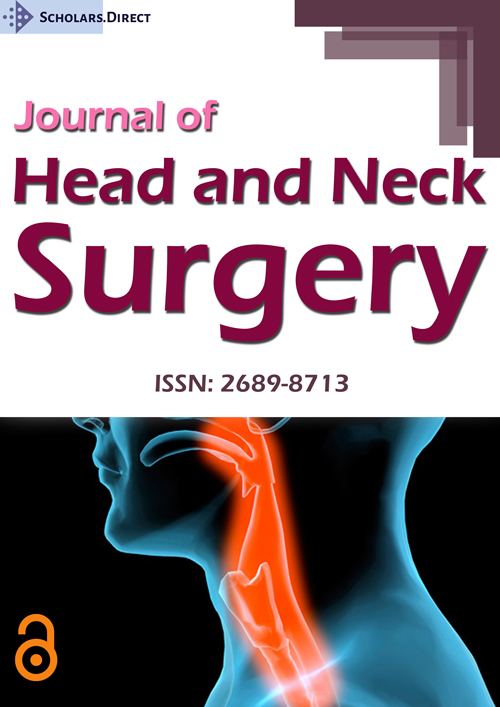Novel Application of Onyx Embolization in the Treatment of Pediatric Tongue Vascular Malformations
Abstract
Background: Vascular malformations of the head and neck can require a multimodal management. The goal of complete removal by surgical resection has been made possible with pre-operative embolization, with reduction in blood loss, operative time, and residual disease. For decades, n-Butyl cyanoacrylate (NBCA) was the agent of choice for embolization. But with the advent of the Onyx liquid system, a new option was presented.
Methods: We performed a literature review on the current management regarding pre-embolization agents and explored the mechanism of the Onyx liquid system. We also describe a case presentation using the Onyx system.
Results: In the literature, the Onyx system has been used successfully in intracranial, and head and neck malformations. However, there is limited literature regarding the application of the system on pediatric lingual malformation. Generally, Onyx did not have statistically significant superiority over NBCA. However, in our experience the Onyx liquid system performs better than NBCA for surgical resection. We theorize that it is likely related to their mechanisms of actions. NBCA causes immediate solidification; therefore, there is less control over injection time, penetration, and extent of solidification. The Onyx system permits more control over the solidification process. This allows for better penetration and an accurate solidification of the vascular malformation, increasing the chances of complete surgical resection.
Conclusions: The Onyx system provides us with an increased chance of complete resection after embolization while minimizing the surgical area in cosmetically or functionally sensitive areas, such as lingual malformations.
Keywords
Vascular malformations, Management, Embolization, Onyx
Introduction
Vascular malformations (VM) are a group of disorders that arise due to embryonic errors in vasculogenesis involving arteries, veins, or lymphatic channels [1]. The International Society for the Study of Vascular Anomalies lists three major types of vascular malformations: venous, lymphatic, and arteriovenous [2]. Venous malformations are the most common type of low-flow lesion and are composed of dilated and dysmorphic venous channels. Sclerotherapy is the first-line treatment option of venous malformations [1,3]. Lymphatic malformations are low-flow lesions composed of dilated lymphatic channels or cysts that are most commonly seen in infants and children less than 2 [4]. Treatment of lymphatic malformations is dependent of the characteristics of the lesion and can include surgical resection, sclerotherapy, or medical therapy with sirolimus [4,5]. Arteriovenous malformations (AVM) are aberrant high-flow connections between arteries and veins that bypass normal capillary beds. Successful treatment requires embolization or surgical resection. Management of vascular malformations usually involve a multidisciplinary team and often a multimodal management with a combination of sclerotherapy, laser therapy, embolization and/or surgical resection [6]. Head and neck malformations in particular can be challenging due to their proximity to functionally or cosmetically important locations. With the advent of innovative treatments, management of these malformations has made it more successful. We explore the differences between two pre-operative embolization agents and how they affect surgical outcomes.
Pre-operative Embolization
Since the 1980s N-butyl cyanoacrylate (NBCA) has been used to embolize a lesion prior to surgical excision of high-flow intracranial and extra cranial arteriovenous malformations, it is efficacious in reducing operative blood loss and allow for complete or partial resection of the lesion [7,8]. NBCA is an adhesive polymer, and it works by forming casts and thrombus once NBCA polymerizes and fills the vascular lumen. It also causes adhesion to the vascular wall, and causes an acute inflammatory reaction with vascular endothelial damage. This results in fibrosis, and enhances the embolizing effects of NBCA [9]. It can be either performed percutaneously or transarterially under sonographic or fluoroscopic guidance. Several studies describe single stage approach with immediate excision of the lesion after embolization [10]. While others report a two-staged approach where the excision is done at a future date within 1 month embolization [11]. Thieu, et al. described an effective single staged approach without associated complications of nerve injury, extra lesion tissue loss or necrosis, ore leaving residual VM, a complete VM removal was achieved without recurrence [10]. Regardless of single or two-staged approach, glue embolization and surgical resection with NBCA is an effective method for treating VMs of the head and neck.
In 2001, the FDA approved ethylene–vinyl alcohol copolymer (Onyx) after the European Union found success in 1999. The Onyx™ liquid embolic system (LES) is a pre-mixed, radiopaque, injectable embolic fluid consisting of the following components: EVOH (ethylene vinyl-alcohol copolymer), DMSO (dimethyl-sulfoxide) and TA (micronized tantalum powder) [12]. The substance works by precipitating instead of polymerizing, to occupy the target area slowly without solidifying immediately like glue. People have described an “outside-in” solidification process with Onyx. A foam like cast forms at the periphery once the substance comes in contract with an ionized fluid like blood, and progresses inward, this is called copolymerization. There is a mild inflammatory reaction that occurs at adjacent vessels, but it does not recanalize after solidification [13]. The Onyx system has been used extensively and successfully in intracranial AVMs [14].
We present a patient who underwent single stage procedure with preoperative embolization using the Onyx system and immediate surgical resection. This is an 11-year-old female with a long standing VM of the tongue. The lesion was measured to be 2 cm in the superficial aspect of the right tongue (Figure 1). We recommended consultation with interventional radiology for pre-operative embolization with immediate surgical resection. The VM was delineated with the use of Onyx embolization injected by Interventional Radiology (Figure 2). The patient was brought to the operating room while intubated and underwent a successful and complete resection of the malformation with minimal blood loss, and minimal resection of the tongue musculature. We were able to achieve primary closure of the wound. The patient had excellent wound healing and no issues with oral intake or speech (Figure 3).
Discussion
Vascular malformations of the head and neck can be complex and challenging, treatment plan with a multidisciplinary team and multimodal management. Sclerotherapy, laser therapy, pre-operative embolization have led to more manageable VMs with success. The goal of complete removal by surgical excision has been made more successful with pre-operative embolization, with reduction in blood loss, operative time, and improvement in complete removal of the VM. NBCA used to be the only substance to achieve that goal. But with the advent of the Onyx liquid system, a new option was presented. In our experience the onyx liquid system performs better than NBCA for surgical excision and it is likely related to their differences in their mechanism of action (Table 1). NBCA is an adhesive polymer that causes immediate solidification [9]. There is less control over extent and penetration of the glue. This may cause incomplete penetration of the vascular malformation, which can lead to inadequate resection of the lesion. While Onyx is a non-adhesive, copolymer, that solidifies only after it contacts ionized fluid [14,15]. This allows for greater control and precision during embolization. This process can be done over 60 minutes if needed, carefully avoiding draining veins by pausing, allowing the Onyx to solidify, and then continuing the injection thus ensuring that the entire nidus of the malformation is covered [15]. In our experience, this has allowed us to minimize the surgical excision in cosmetically or functionally sensitive areas.
Loh and Duckwiler performed a multicenter, randomized trial comparing NBCA to the Onyx system in embolizing AVMs. Their primary outcome was technical success in reducing the AVM volume by > 50%, other outcomes were operative blood loss and procedure time. They found the Onyx system is equivalent to the NBCA as a preoperative embolic agent, Onyx achieved volume reduction in 96% or cases compared to 85% for NBCA, however, not statistically significant [16]. Velat, et al. found that the Onyx system there were more fluoroscopy and procedures times when compared with NBCA, [17] likely since Onyx permits the user to take their time to allow for full penetration of the VM. However, there were no significant differences in complications or blood loss. We believe that with an experienced operator, the Onyx liquid system can be injected efficiently and safely to allow for successful resection of a vascular malformation without compromising function or cosmesis.
Conclusion
Managing vascular malformations require a multimodal treatment plan. While sclerotherapy and laser therapy have their place in the algorithm, pre-operative embolization with either NBCA or Onyx have lead to successful results. Each patient is unique and the modality of treatment should be tailored to their type of malformation.
Acknowledgements
We thank the patient for providing consent to present their case in this article.
Funding
None.
Conflict of Interest
The authors have no conflicts of interest.
Financial Disclosure
The authors have no financial disclosures.
References
- Zhang B, Ma L (2018) Updated classification and therapy of vascular malformations in pediatric patients. Pediatric Investigation 2: 119-123.
- ISSVA (2017) Classification of Vascular Anomalies 2014 International Society for the Study of Vascular Anomalies.
- Gibson CR, Barnacle AM (2020) Vascular anomalies: Special considerations in children. CVIR Endovasc 3: 60.
- Boardman SJ, Cochrane LA, Roebuck D, et al. (2010) Multimodality treatment of pediatric lymphatic malformations of the head and neck using surgery and sclerotherapy. Archives of Otolaryngology Head & Neck Surgery 136: 270-276.
- Greinwald DK, Pransky JH, Kelley S, et al. (2002) Treatment of lymphangiomas with OK-432 (Picibanil) sclerotherapy: A prospective multi-institutional trial. Arch Otolaryngol Head Neck Surg 128: 1137-1144.
- Mahady K, Thust S, Berkeley R, et al. (2015) Vascular anomalies of the head and neck in children. Quant Imaging Med Surg 5: 886-897.
- Churojana A, Chiewwit P, Chuangsuwanich A, et al. (2004) Embolization of vascular malformations in head and neck regions. Interv Neuroradiol 10: 37-46.
- Brothers MF, Kaufmann JC, Fox AJ, et al. (1989) n-Butyl 2-cyanoacrylate--substitute for IBCA in interventional neuroradiology: Histopathologic and polymerization time studies. AJNR Am J Neuroradiol 10: 777-786.
- Takeuchi Y, Morishita H, Sato Y, et al. (2014) Guidelines for the use of nbca in vascular embolization devised by the committee of practice guidelines of the Japanese society of interventional radiology (cgjsir), 2012 edition. Jpn J Radiol 32: 500-517.
- Tieu DD, Ghodke BV, Vo NJ, et al. (2013) Single-stage excision of localized head and neck venous malformations using preoperative glue embolization. Otolaryngol Head Neck Surg 148: 678-684.
- Uller W, El-Sobky S, Alomari AI, et al. (2018) Preoperative embolization of venous malformations using n-butyl cyanoacrylate. Vasc Endovascular Surg 52: 269-274.
- Medtronic (2022) AVM embolization products - onyx. Medtronic.
- Guimaraes M, Wooster M (2011) Onyx (ethylene-vinyl alcohol copolymer) in peripheral applications. Seminars in Interventional Radiology 28: 350-356.
- Siekmann R (2005) Basics and principles in the application of onyx LD liquid embolic system in the endovascular treatment of cerebral arteriovenous malformations. Interv Neuroradiol 11: 131-140.
- Van Rooij WJ, Sluzewski M, Beute GN (2007) Brain AVM embolization with Onyx. AJNR American Journal of Neuroradiology 28: 172-178.
- Loh Y, Duckwiler GR (2010) A prospective, multicenter, randomized trial of the onyx liquid embolic system and N-butyl cyanoacrylate embolization of cerebral arteriovenous malformations. Clinical article. J Neurosurg 113: 733-741.
- Velat GJ, Reavey-Cantwell JF, Sistrom C, et al. (2008) Comparison of N-butyl cyanoacrylate and onyx for the embolization of intracranial arteriovenous malformations: Analysis of fluoroscopy and procedure times. Neurosurgery 63.
Corresponding Author
Ramya Bharathi, Department of Otolaryngology, Tufts Medical Center, 800 Washington St Box 850, Boston, MA, 02111, USA, Tel: 617-636-7878.
Copyright
© 2024 Bharathi R, et al. This is an open-access article distributed under the terms of the Creative Commons Attribution License, which permits unrestricted use, distribution, and reproduction in any medium, provided the original author and source are credited.







